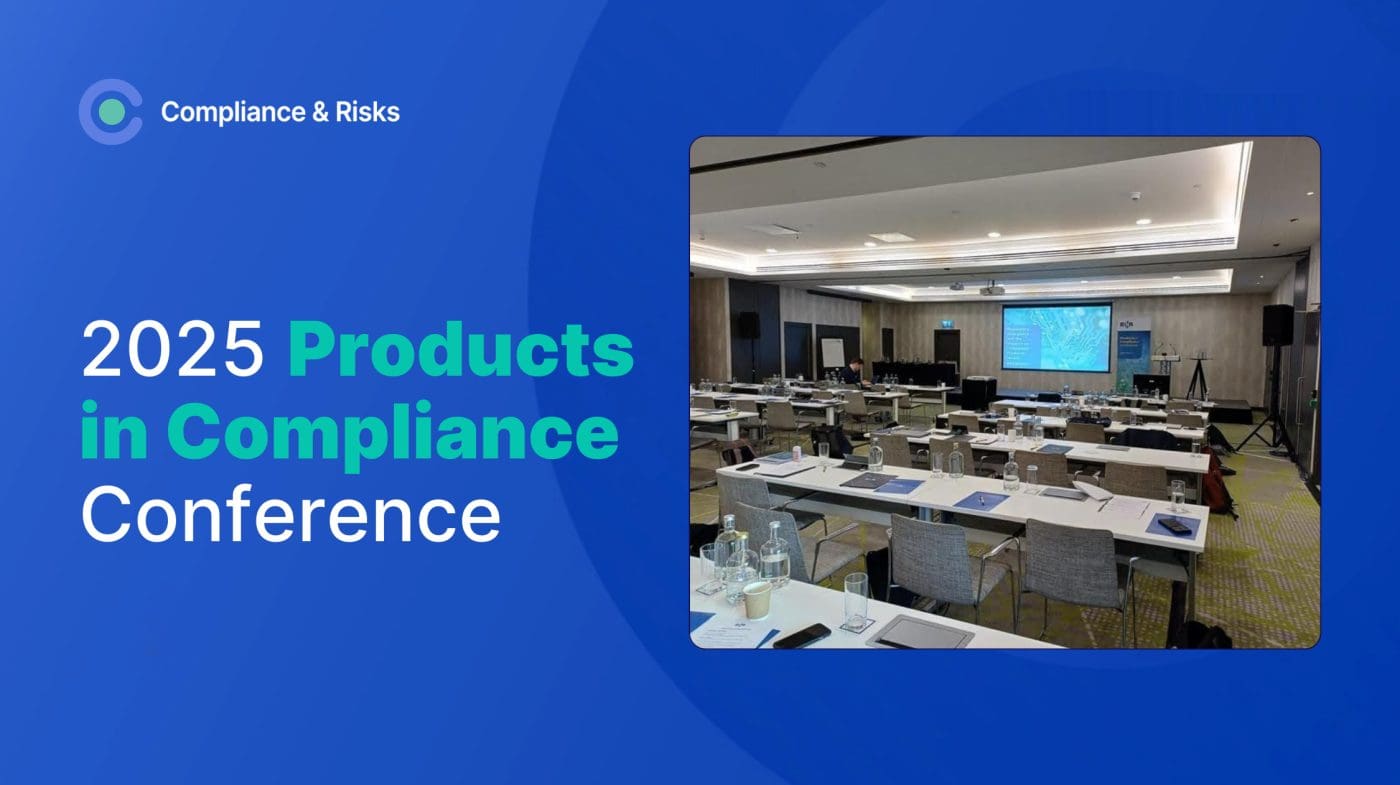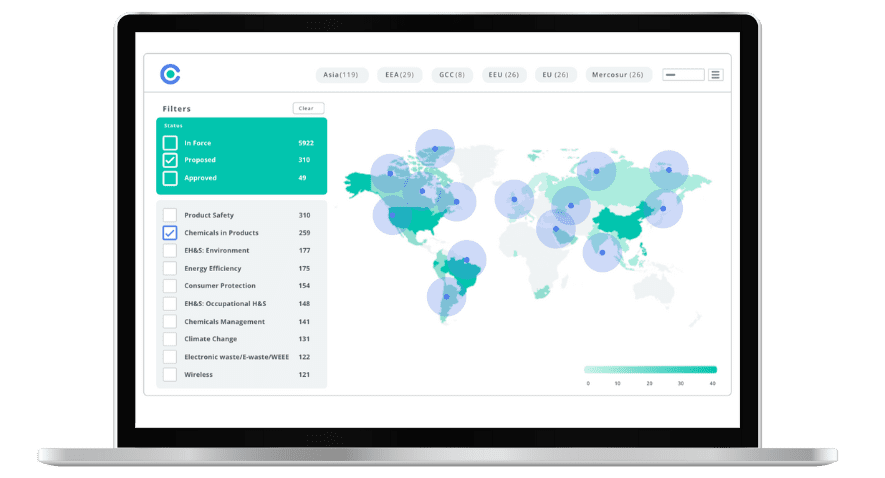
Top Takeaways from the 2025 Products in Compliance Conference with RINA

This blog was originally posted on 27th November, 2025. Further regulatory developments may have occurred after publication. To keep up-to-date with the latest compliance news, sign up to our newsletter.
AUTHORED BY CHELSEA NÍ CHUINNEAGÁIN, SENIOR REGULATORY COMPLIANCE SPECIALIST AND KNOWLEDGE PARTNER COORDINATOR, COMPLIANCE & RISKS
Looking Ahead: The 2025 Compliance Landscape
At the 2025 Products in Compliance Conference I gained a forward looking view of the increasingly complex regulatory landscape. Sessions were built logically across two days, highlighting regulatory evolution, industry preparedness, and the growing importance of data-driven compliance.
Global Chemical and Electrical Compliance Updates
Antony Lord (RINA) presented PFAS regulations, summarizing existing laws, countries currently requiring reporting, and emerging legislation. Emily Tyrwhitt Jones (RINA) updated delegates on RoHS, covering EU and UK frameworks, alternative procedures, and global requirements, giving a clear picture of worldwide chemical and electrical product compliance.
Highlights included conversation around how PFAS compliance is no longer limited to chemicals regulation per se, but extends to packaging, consumer goods, and supply-chain transparency. Manufacturers, importers and downstream users should be alert to tightening thresholds, expanded substance scope, and likely further bans or restrictions over the next few years.
Compliance by Design
A key theme was embedding regulatory requirements into the product development lifecycle. Sumithra Appa Rao (RINA) shared strategies for implementing effective compliance systems, remaining audit ready, managing obligations efficiently, and responding to regulatory changes. Chelsea Ní Chuinneagáin (C&R) explored navigating global compliance beyond the EU, addressing regulatory divergences and multinational challenges. Discussions around a potential antidote to global complexity of regulations and their divergence included but was not limited to:
- Design-In Compliance: Embed regulatory requirements as mandatory specifications at the start of the development lifecycle;
- Single Source of Truth (SSoT): Utilize a centralized, authoritative platform for all regulatory evidence, technical files, and documentation to ensure instant audit readiness and just for ease of a central management system;
- Local Partnerships: Leverage accredited local labs and authorized representatives to manage country-specific certification and submission protocols;
- Continuous Regulatory Intelligence: Implement a structured system for tracking and integrating new legislative mandates in real-time; and
- Cross-Functional Accountability: Mandate comprehensive training to ensure every team, from Legal to Engineering, understands their specific regulatory burden within the CMS.
Navigating UK Regulations and Cybersecurity
Sarah Smith from the OPSS outlined the UK’s evolving product regulation landscape, sector-specific approaches, and next steps. Ashley Weeks (RINA) provided guidance on cybersecurity legislation, including UK PSTI and the EU Cyber Resilience Act. Daniel Roberts offered insights on horizon scanning, manufacturer and importer obligations, and strategies for handling regulatory divergence and complex compliance data.
He outlined practical methods such as tracking consultations, monitoring regulatory roadmaps, using structured data tools to flag potential impacts, and integrating early signals into product planning cycles. This approach helps manufacturers and importers anticipate shifts in compliance obligations, prepare for regulatory divergence between markets, and manage increasingly complex data requirements with greater accuracy and confidence.
Sustainability and Due Diligence in Focus
Prerna Chaturvedi (RINA) covered the CSRD and CSDDD, explaining scope, timelines, human rights, environmental expectations, the ESRS framework, and affected stakeholders. She highlighted how the ESRS framework translated these obligations into detailed disclosure requirements and highlighted the broad range of stakeholders affected, from large EU companies to non EU entities with significant EU activity.
Liz Kimber explained legislative requirements for product manufacturers across batteries, packaging, and other products, along with practical compliance strategies for interpreting new rules, managing data heavy reporting obligations, and integrating sustainability.
Real-World Case Studies
Rob Squires and Hitomi Nakamura of Brother Europe Ltd shared how circular business models and sustainable resource use were implemented. They highlighted drivers of change, including legislation, customer expectations, and market differences, and showed how environmental obligations were embedded into design and operations.
Integrating ESG, Supplier Data, and Compliance
Breakout sessions emphasized the overlap between ESG reporting, responsible sourcing, and conflict minerals compliance. Focus was placed on optimizing supplier data management, improving transparency and traceability, and aligning internal systems with emerging disclosure requirements. Core compliance practices such as CE marking, product testing, and conflict minerals due diligence were reinforced as foundational.
Conclusion
RINA is a valued member of the Knowledge Partner Programme at Compliance & Risks, who provide independent expertise across product manufacturing, design, and sustainability. Their guidance compliments the decision-making, thought leadership, and regulatory intelligence here at Compliance & Risks helping organisations stay ahead of evolving compliance requirements.
Find out more information on joining our Knowledge Partner Programme here.
Stay Ahead Of Regulatory Changes
Want to stay ahead of these regulatory developments? Accelerate your ability to achieve, maintain & expand market access for all products in global markets with C2P – your key to unlocking market access, trusted by more than 300 of the world’s leading brands.
C2P is an enterprise SaaS platform providing everything you need in one place to achieve your business objectives by proving compliance in over 195 countries.
C2P is purpose-built to be tailored to your specific needs with comprehensive capabilities that enable enterprise-wide management of regulations, standards, requirements and evidence.
Add-on packages help accelerate market access through use-case-specific solutions, global regulatory content, a global team of subject matter experts and professional services.
- Accelerate time-to-market for products
- Reduce non-compliance risks that impact your ability to meet business goals and cause reputational damage
- Enable business continuity by digitizing your compliance process and building corporate memory
- Improve efficiency and enable your team to focus on business critical initiatives rather than manual tasks
- Save time with access to Compliance & Risks’ extensive Knowledge Partner network

Cutting Through the Chaos: A 2025-2026 Survival Guide to ESG, Sustainability & Product Compliance
Unpack the latest regulatory developments in 2025, gain practical insights, and learn what’s coming next in 2026!
Whether you’re grappling with deadlines or planning for future compliance, join us for a roadmap to navigate the challenges and opportunities ahead.



